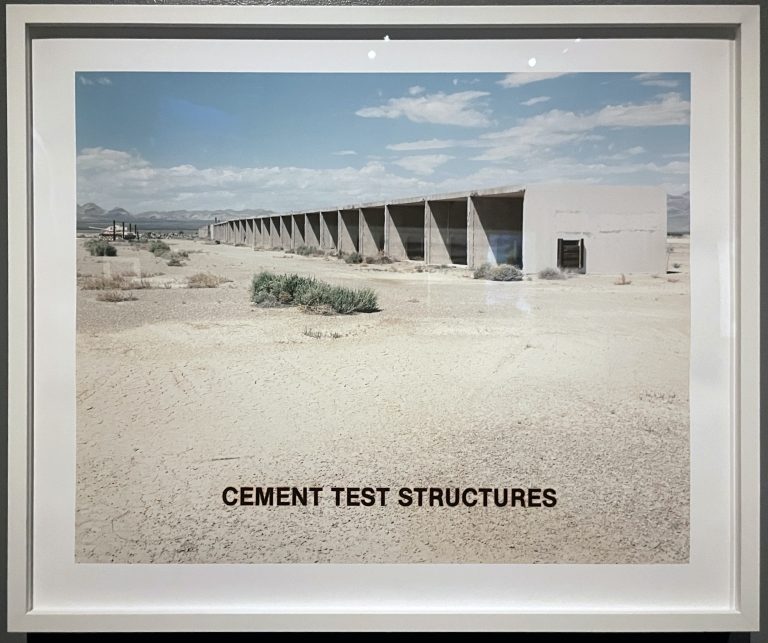LOS ANGELES — The Autry Museum of the American West often paints romantic images of the Wild West in faded gold, brown and sage tones. Off the Field: Investigative Science and the Hidden WestHowever, he swapped these colors for silver and black, creating a dark atmosphere that illustrates the sinister undertones of the art.
The exhibition, part of Getty’s PST: Art and Science Collide, focuses on the scientific tools used to map the resource-rich landscapes of the West and explores how these technologies transformed into destructive forces. Actor Gene Autry’s jubilant Hollywood playground sits on a land scarred by genocide, genocide and the ecological devastation of military testing.
The exhibition immediately places visitors in an uncomfortable position by projecting their images onto the entrance wall, captured via an infrared camera mounted on a drone-mounted perforated metal sculpture. This establishes the show’s through-line, which is the connection between the words “investigation” and “surveillance”, which share the same French root “sur” meaning Exceed. However Outside the site What do you care about more? below — natural gas in the ground, uranium hidden in the mountains, and the people beneath those faceless military drones buzzing in the sky.

Many historical writings incidentally depict the resources that made the West an opportunity for plunder. Thomas Moran’s gold-framed “Hot Springs of Yellowstone” (1872) is a warm field study of a geothermal pool landscape. In the background of the painting, a rainbow emerges from the cloudy sky, heralding the promise and potential of the newly discovered territory. But natural gas is what paints these pools so beautifully, which is why this land was forcibly taken from Aboriginal hands and then plundered to generate electricity in an industrialized country. In stark contrast to Moran’s painting is Julie Shafer’s silver gelatin pinhole negative “Conquering the Vertical: 300 Miles to Eureka! (no. 3)” (2013), a Black and white image of the mine. The negative’s color inversion turns the object into a ghostly shape, making the small pool appear eerie and unsettling. Schaeffer’s decision to use a development process that included silver salts is noteworthy because they were extracted from the West. one of the elements.
In addition to mining, the U.S. government’s mistaken belief that the West was uninhabited also made it a military testing ground. Perhaps the most famous example is nuclear testing, which was most active in the 1950s and 1960s. Most nuclear weapons research takes place in the Southwest back The bombing of Hiroshima and Nagasaki. The military didn’t know the full health effects of these weapons, but still dumped them on Indigenous lands for decades.

Significant records exist of the bombs dropped in Nevada and New Mexico, and Yulia Pinkusevic depicted the explosions in her otherworldly charcoal drawings. nuclear sun series (2010). Nine drawings depict mushroom clouds from an unusual fish-eye perspective, making them look like tumors captured in ultrasound. Pinkusevich’s drawing references images captured by Harold E. Edgerton’s “Mirror Ball” (1954), a silver ball that made it easier to photograph explosions from a 180-degree perspective; it is displayed alongside the drawing.
The military also uses the West as a place to test surveillance technology. In “Satellite Alignment Mark AF49” (2015) by Julie Anand and Damon Sauer ground truth Photography series, four trapezoidal concrete bricks form a starburst pattern. They look like land art, but are actually calibration marks for surveillance satellites active during the Cold War. Artists added white lines crisscrossing the sky, tracing the paths of satellites. In the modern era, drones fly overhead, primarily tracking people crossing borders so law enforcement can apprehend them.
Outside the site It’s a surprisingly bleak exhibition for an art institution that usually focuses on the connection between the West and popular entertainment, but importantly the Autry Museum looks squarely at the hills, arches and canyons lurking on the Stolen Frontier Dark history below.





Off the Field: Investigative Science and the Hidden West The exhibition will remain on display at the Autry Museum of the American West (4700 West Heritage Road, Griffith Park, Los Angeles) until January 5, 2025. The exhibition is curated by Amy Scott.

